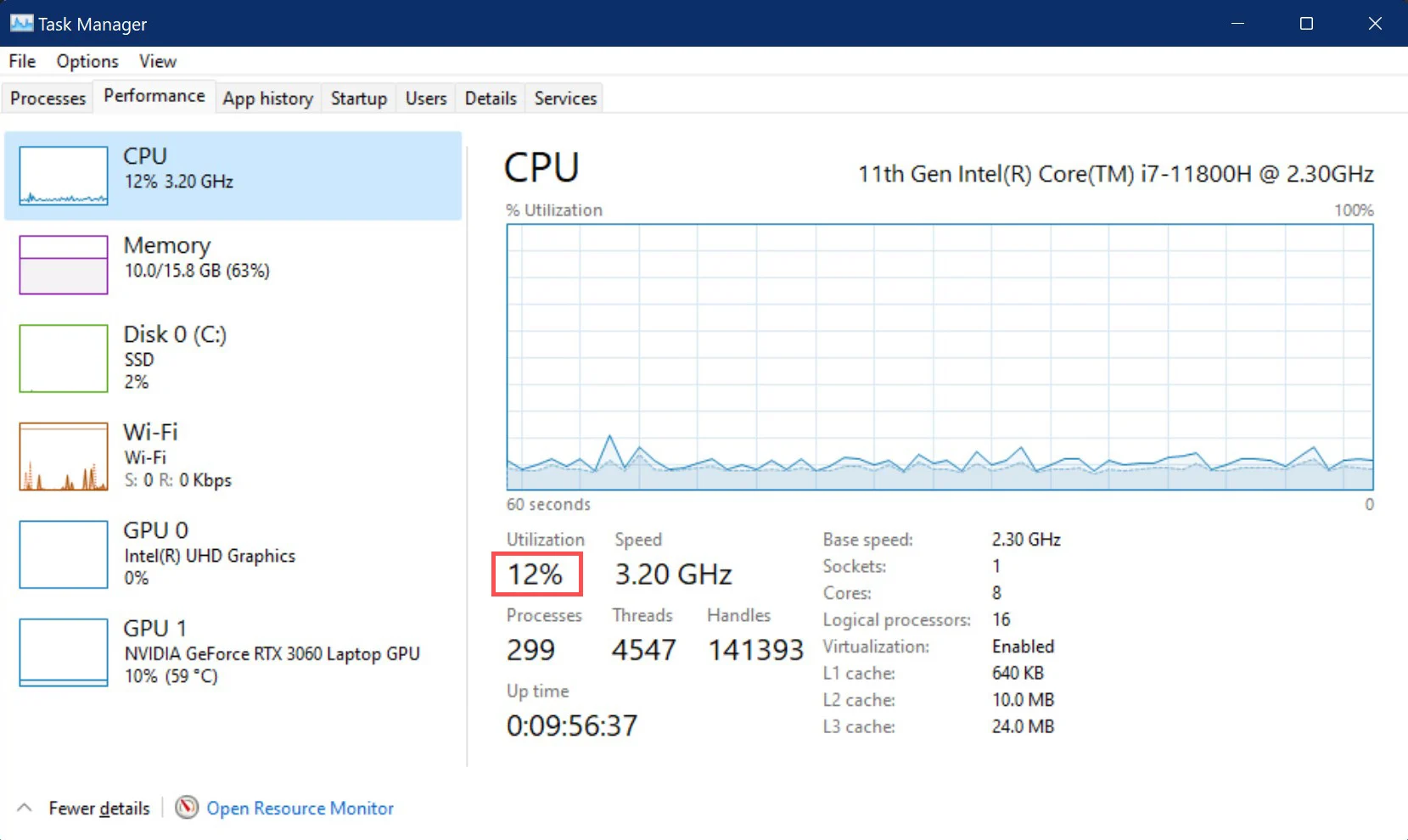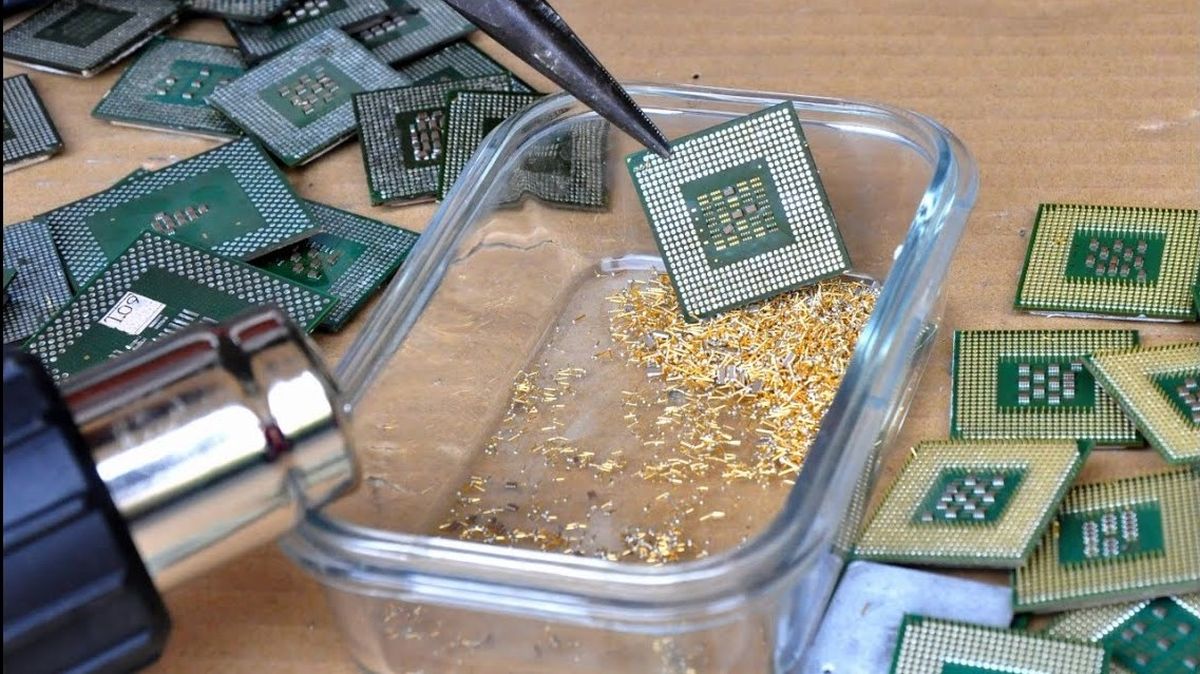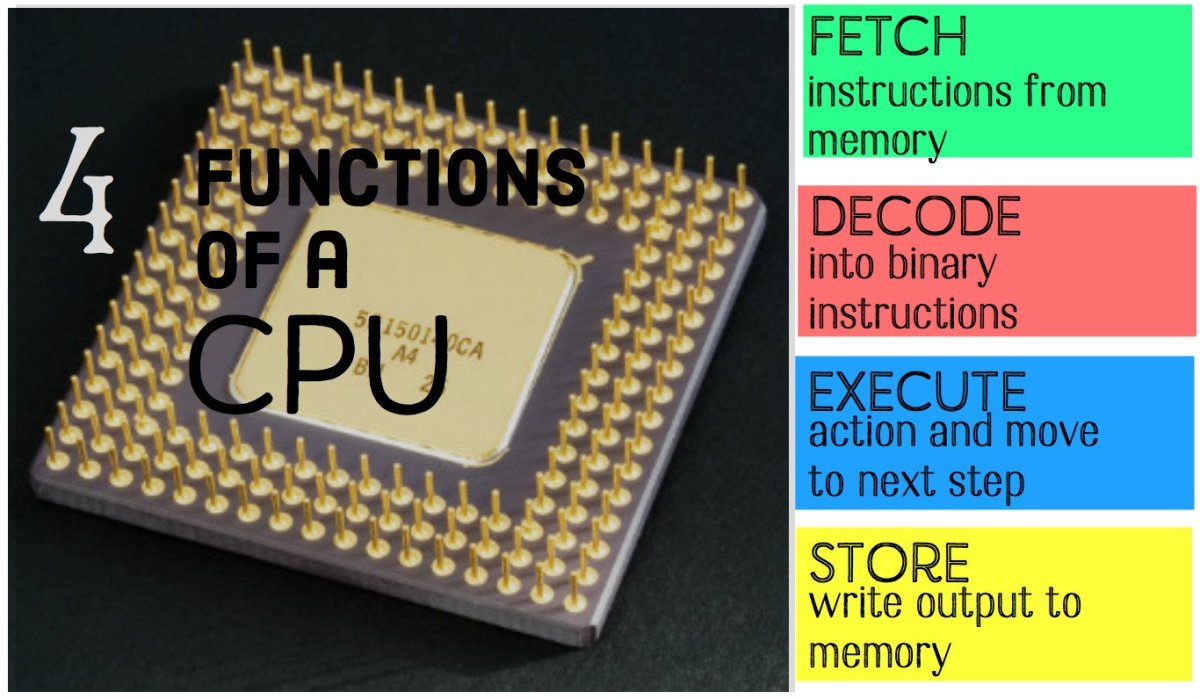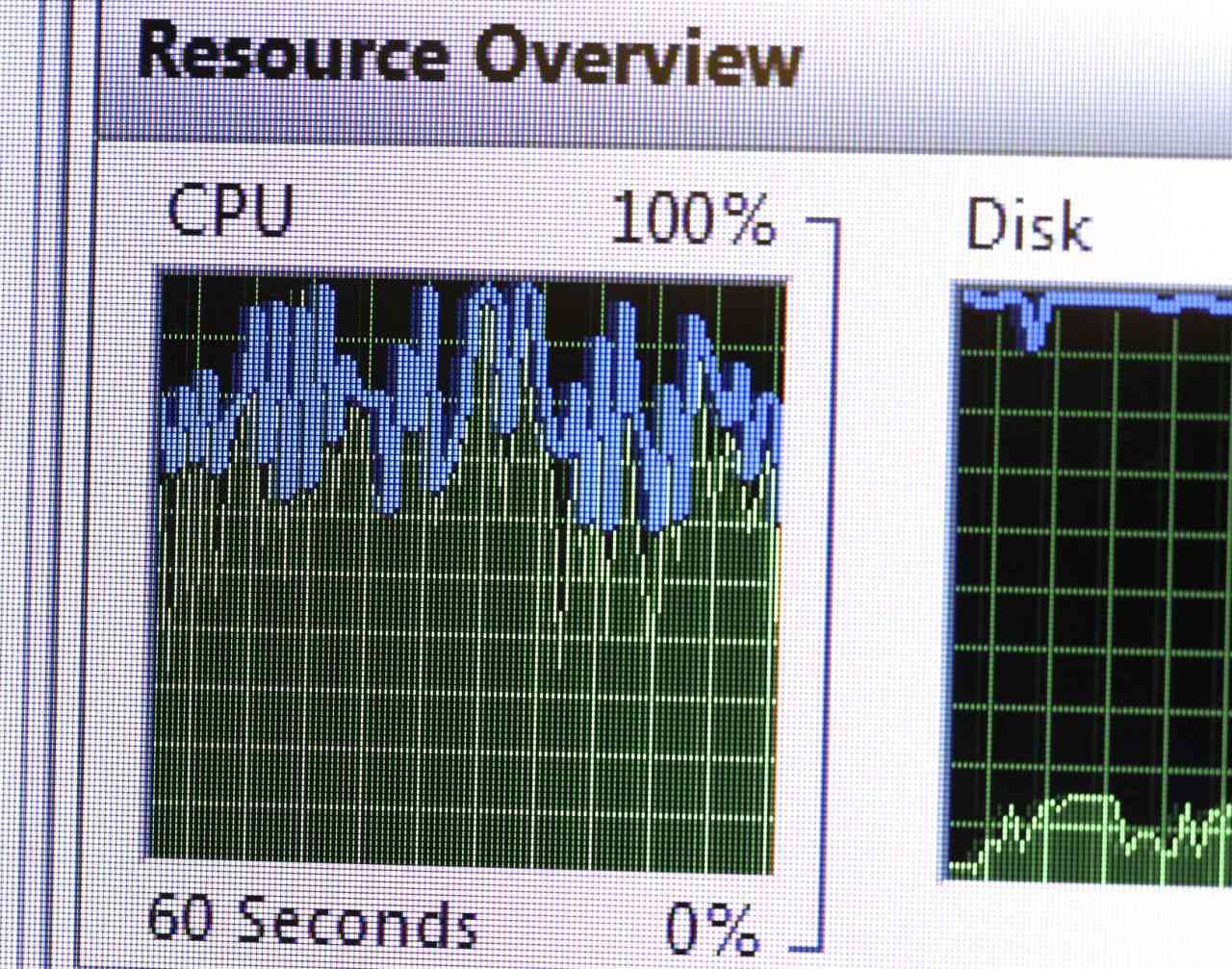Introduction
One frustrating situation that many computer users encounter is high CPU usage with seemingly nothing running. You might notice that your computer is sluggish, unresponsive, or even overheating without any apparent reason. So what exactly is causing your CPU usage to skyrocket?
CPU usage refers to the amount of processing power that your computer’s central processing unit (CPU) is utilizing at any given time. When the CPU usage is high, it indicates that the processor is working harder than it should be, which can result in performance issues and decreased system responsiveness.
Understanding the common causes of high CPU usage can help you diagnose the issue and take appropriate measures to resolve it. In this article, we will explore various factors that can contribute to high CPU usage, ranging from background processes to resource-heavy applications. By identifying the root cause, you can effectively reduce the strain on your CPU and improve your computer’s performance.
It’s important to note that high CPU usage can occur on any computer, regardless of the operating system or hardware configuration. Whether you’re using a Windows, Mac, or Linux-based system, the following information will help you pinpoint the cause of your high CPU usage problem.
Let’s dive into the common causes in the next section to better understand why your CPU usage is acting up.
What is CPU Usage?
CPU usage refers to the percentage of a computer’s processing power that is being used by the central processing unit (CPU) at a given time. It is a measure of how actively the CPU is working to execute tasks and handle the operations of the computer system.
When you open an application, run a program, or perform any task on your computer, the CPU is responsible for executing the instructions and processing the data involved. The CPU usage is dynamic and can vary depending on the workload. It can range from minimal usage when the computer is idle to high usage when the CPU is processing resource-intensive tasks.
CPU usage is typically expressed as a percentage and can be monitored in real-time through task managers or system monitoring utilities. A value of 0% means that the CPU is not actively working on any task, while 100% indicates that the CPU is fully occupied and working at its maximum capacity.
Understanding CPU usage is essential for assessing the performance of your computer. When the CPU usage is consistently high, it can indicate that there is a problem, such as excessive background processes, software conflicts, or hardware limitations, that needs to be addressed.
It’s important to note that CPU usage can vary from system to system. A CPU with multiple cores or threads can handle more tasks simultaneously, resulting in lower overall usage even during high-demand situations. Additionally, different applications and processes will have varying impacts on CPU usage. Resource-intensive applications, such as video editing software or complex gaming, will naturally require more CPU power than simple word processors or web browsers.
Monitoring your CPU usage can help you identify potential bottlenecks, optimize system performance, and diagnose issues that may be causing your computer to slow down or become unresponsive. By keeping an eye on your CPU usage, you can ensure that your computer is operating smoothly and efficiently.
Common Causes of High CPU Usage
Experiencing high CPU usage can be frustrating, as it can significantly impact the performance and responsiveness of your computer. There are several common causes of high CPU usage that you should be aware of:
- Background Processes: One of the most common culprits of high CPU usage is background processes. These are programs and services that run in the background without your knowledge, consuming valuable CPU resources. Examples include antivirus scans, system updates, and scheduled tasks. To identify and manage these processes, you can use the task manager or a third-party system monitoring tool.
- Malware or Viruses: Malicious software can cause your CPU to work overtime. Viruses, spyware, and other malware can run hidden processes in the background, hogging your CPU resources. Performing regular malware scans with reputable antivirus software is crucial to detect and remove any malicious programs that may be causing high CPU usage.
- Outdated Drivers: Outdated or faulty device drivers can also result in high CPU usage. When drivers are incompatible or outdated, they may not properly communicate with your operating system, causing the CPU to work harder than necessary. Regularly updating your drivers, especially for graphics cards and audio devices, can help resolve this issue.
- Insufficient Computer Memory (RAM): Insufficient RAM can lead to high CPU usage as your computer compensates for the lack of memory by utilizing more of the processor’s resources. If your computer frequently runs out of memory, consider upgrading your RAM to provide sufficient space for the operating system and applications to run smoothly.
- Overheating: Overheating can cause your CPU to become overworked, leading to high CPU usage. Dust buildup, inadequate cooling, or a malfunctioning fan can affect the temperature of your CPU. Ensure that your computer is clean and well-ventilated, and consider using cooling pads or fans to prevent overheating.
- Power Settings: Power settings on your computer can also affect CPU usage. In some instances, your computer may be set to a high-performance mode, which keeps the CPU running at maximum speed even when idle. Adjusting power settings to a balanced or power-saving mode can help reduce unnecessary CPU usage.
- Corrupted System Files: Corrupted or damaged system files can cause your CPU to work harder to execute tasks. Running system file check utilities on your computer, such as the Windows System File Checker, can help detect and repair any corrupted files that may be contributing to high CPU usage.
- Resource-Heavy Applications: Certain applications or processes can put a significant strain on your CPU, resulting in high CPU usage. Video editing software, games, and other resource-intensive programs often require substantial processing power. Closing unnecessary applications and limiting background processes can alleviate the CPU load.
Identifying the underlying cause of high CPU usage is crucial for effectively resolving the issue. By addressing these common causes, you can optimize your computer’s performance and ensure a smoother computing experience.
Background Processes
Background processes are programs and services that run on your computer without your direct interaction. While many of these processes are essential for the smooth functioning of your operating system, they can also contribute to high CPU usage if they become excessive or problematic.
Background processes can include system updates, anti-malware scans, software updaters, and various system maintenance tasks. These processes often run in the background to ensure that your computer stays up-to-date, protected from threats, and optimized for performance.
However, in some instances, background processes can go haywire and consume an excessive amount of CPU resources. This can happen due to conflicts between software, faulty updates, or misconfigurations. When this occurs, it can lead to significant slowdowns, unresponsiveness, and high CPU usage.
To identify and manage background processes, you can use the built-in task manager on your operating system or a third-party system monitoring tool. These tools allow you to view the list of running processes, sort them by CPU usage, and determine which ones are consuming an excessive amount of resources.
If you notice that a specific background process is consistently using a high percentage of your CPU, you can take several steps to address the issue:
- Update or Reinstall the Problematic Software: If a specific software’s background process is causing high CPU usage, check if there is an available update for that software. Installing the latest version may fix any bugs or compatibility issues that were causing the excessive resource usage. If updating doesn’t resolve the problem, consider uninstalling and reinstalling the software.
- Adjust Background Process Settings: Some software allows you to adjust the frequency or intensity of background processes. For example, antivirus software usually provides options to customize scan schedules. Review the settings of the problematic software and adjust them according to your needs and preference, striking a balance between system protection and CPU usage.
- Disable or Remove Unnecessary Background Processes: Take a closer look at the list of background processes and identify any that are unnecessary or unwanted. These could be third-party software updaters, system optimizers, or other tools that you don’t use or don’t need. Disabling or uninstalling these processes can help reduce CPU usage and free up system resources.
- Manage Startup Programs: Some background processes are launched automatically when you start your computer. These can contribute to high CPU usage if there are too many or if they are resource-intensive. To manage startup programs, you can use the System Configuration utility (Windows) or the Login Items settings (Mac). Disable or remove unnecessary startup programs to reduce the CPU load during boot.
By addressing problematic background processes, you can significantly reduce high CPU usage and improve the overall performance of your computer. Regularly reviewing and managing background processes is an essential maintenance task to ensure a smooth and optimized computing experience.
Malware or Viruses
Malware and viruses can wreak havoc on your computer’s performance, and one of the common symptoms is high CPU usage. Malicious software can infiltrate your system, run hidden processes in the background, and consume an excessive amount of CPU resources.
Malware can take various forms, including viruses, worms, trojans, spyware, and adware. These malicious programs can enter your computer through infected email attachments, software downloads from untrusted sources, malicious websites, or even through exploiting vulnerabilities in outdated software.
When malware infects your system, it often operates stealthily, running background processes without your knowledge or consent. These processes can run continuously, consuming significant CPU resources and causing high CPU usage. In addition to high CPU usage, you may also experience other symptoms such as system slowdowns, frequent crashes, unwanted pop-ups, or unusual network activity.
To address malware or virus-related high CPU usage, follow these steps:
- Install and Update Antivirus Software: A reliable and up-to-date antivirus software is essential for detecting and removing malware. Install a reputable antivirus program on your computer and ensure that it is regularly updated. Perform a full system scan to identify and eliminate any malware or viruses that may be causing high CPU usage.
- Use Anti-Malware Tools: In addition to antivirus software, consider using dedicated anti-malware tools. These tools can provide an extra layer of protection against malware and can help detect and remove specific types of threats that traditional antivirus programs may miss.
- Scan for Malware in Safe Mode: Some malware may be designed to evade detection by the installed antivirus software. In such cases, try running a full system scan in safe mode. Safe mode boots your computer with only the essential services and drivers, which can help isolate and remove stubborn malware.
- Be Cautious with Downloads and Email Attachments: Avoid downloading software or files from untrusted sources. Be cautious when opening email attachments, especially if they come from unknown or suspicious senders. Always scan downloaded files with antivirus software before opening them.
- Keep Software and Operating System Updated: Regularly update your operating system, web browsers, and other software on your computer. Updates often include security patches that can patch vulnerabilities that malware may exploit. Enable automatic updates whenever possible to ensure your system stays protected.
- Be Wary of Phishing Attempts: Phishing emails and websites can trick you into unknowingly downloading malware or revealing sensitive information. Be cautious of suspicious emails, messages, or links requesting personal information or login credentials. Avoid clicking on suspicious links and verify the legitimacy of websites before entering any sensitive data.
- Backup Files Regularly: Create regular backups of your important files to an external storage device or cloud storage. In the event of a malware infection or system compromise, having backups ensures that you can restore your files without losing valuable data.
By taking proactive measures to protect your computer against malware and viruses, you can significantly reduce the risk of high CPU usage and maintain a secure and optimized system.
Outdated Drivers
Outdated or faulty drivers can contribute to high CPU usage on your computer. Drivers are software components that facilitate communication between your operating system and hardware devices, such as graphics cards, sound cards, and network adapters. When drivers become outdated or incompatible, they may not function properly, resulting in increased CPU usage.
Outdated drivers can lead to several issues, including excessive CPU usage, system crashes, and poor performance. Here’s how outdated drivers can cause high CPU usage:
Compatibility Issues: Newer versions of operating systems often introduce changes that may not be compatible with older drivers. This can result in conflicts and errors, leading to increased CPU usage as the system attempts to compensate for the miscommunications.
Missing Enhancements: Driver updates often include performance enhancements and bug fixes, optimizing the way hardware interacts with the operating system. Outdated drivers may lack these improvements, causing inefficient resource utilization and high CPU usage.
Hardware Inefficiency: Older drivers may not fully utilize the capabilities of your hardware, forcing the CPU to compensate and perform tasks that could be handled more efficiently by the hardware itself. This can result in increased CPU usage and decreased system performance.
To address high CPU usage caused by outdated drivers, follow these steps:
- Identify Outdated Drivers: Start by identifying which drivers on your system are outdated. You can visit the website of the hardware manufacturer or use driver updater software to scan for outdated drivers. These tools can automatically detect and update the drivers, ensuring compatibility and optimal performance.
- Manually Update Drivers: If you prefer to update drivers manually, visit the manufacturer’s website for each device and search for the latest driver version. Download the appropriate driver for your operating system and hardware model, then follow the manufacturer’s instructions to install the updated driver.
- Use Device Manager: On Windows, you can use the Device Manager to update drivers. Right-click on the Start button, select “Device Manager,” and expand the categories to locate the device for which you want to update the driver. Right-click on the device and select “Update driver.” Choose the option to search for updated drivers automatically or specify the location of the downloaded driver file.
- Automatic Updates: Enable automatic driver updates if available. Some operating systems and driver updater software offer this option, which can automatically download and install the latest driver versions for your hardware. This ensures that your drivers stay up to date without requiring manual intervention.
- Reboot Your Computer: After updating the drivers, restart your computer. This allows the changes to take effect and ensures that the updated drivers are properly loaded.
Regularly updating your drivers can help maintain compatibility, optimize performance, and reduce high CPU usage. Keeping your drivers up to date is an essential maintenance task that ensures your computer’s hardware operates efficiently and smoothly.
Insufficient Computer Memory (RAM)
If your computer has insufficient memory (RAM), it can lead to high CPU usage. RAM is a vital component of your computer that provides temporary storage for data that the CPU needs to access quickly. When the available RAM is not enough to accommodate the data required for running programs and processes, the CPU compensates by working harder, leading to increased CPU usage.
Insufficient RAM can cause several issues, including slow performance, frequent freezes, and high CPU usage. Here’s how insufficient memory can contribute to high CPU usage:
Increased Reliance on Virtual Memory: When your computer runs out of available RAM, it relies on virtual memory, which uses a portion of your hard drive as temporary storage. However, accessing data from virtual memory is slower than accessing data from RAM. As a result, the CPU may need to wait longer for data, leading to increased CPU usage.
Excessive Page File Usage: The page file is a portion of your hard drive that serves as an extension of RAM. When RAM is insufficient, the page file is used to temporarily store data that cannot fit into physical memory. However, excessive usage of the page file can significantly impact CPU performance, leading to high CPU usage as the CPU works to manage the constant swapping of data between RAM and the page file.
Resource Hogging Applications: Applications that require a significant amount of memory to run, such as resource-intensive games or professional software, can put a strain on your system’s available memory. When these applications cannot find enough free RAM, the CPU is forced to work harder and allocate more resources to keep the applications running, resulting in increased CPU usage.
To address high CPU usage caused by insufficient computer memory, consider taking the following steps:
- Check Task Manager: Open the Task Manager (Windows) or the Activity Monitor (Mac) and monitor the memory usage of different programs and processes. Identify any resource-hogging applications that are using excessive amounts of memory. Close unnecessary applications and processes to free up memory and reduce CPU usage.
- Upgrade RAM: If you consistently experience high CPU usage due to insufficient memory, consider upgrading your RAM. Increasing the amount of RAM can provide more space for data and reduce reliance on virtual memory, resulting in improved system performance and decreased CPU usage.
- Manage Startup Programs: Some applications launch automatically when you start your computer, using up valuable memory. Disable or remove unnecessary startup programs to free up memory for more important tasks.
- Optimize Virtual Memory (Windows): Adjust the virtual memory settings in Windows to optimize performance. Increase the virtual memory allocation or let the system manage it automatically. This can help reduce the strain on the CPU caused by excessive page file usage.
- Close Unnecessary Applications: If you are running resource-intensive applications, closing unnecessary background applications can free up memory for the tasks at hand. Consider closing web browsers with multiple tabs or any other applications that are not in use.
- Clear Temporary Files: Temporary files, such as browser cache, can consume disk space and affect system performance. Clearing these files can free up memory and improve overall performance.
By ensuring that your computer has sufficient RAM and optimizing its usage, you can alleviate high CPU usage caused by memory limitations. Adequate memory is essential for smooth multitasking, efficient program execution, and overall improved system performance.
Overheating
Overheating is a common cause of high CPU usage. When your computer’s components, particularly the CPU, become too hot, it can lead to increased CPU usage as the system attempts to cool down the overheating components. This can result in system slowdowns, performance issues, and even unexpected shutdowns.
Several factors can contribute to overheating, including:
Dust and Dirt Accumulation: Over time, dust and dirt can accumulate inside your computer, especially in the CPU cooling system. This buildup restricts airflow and prevents proper heat dissipation, causing the CPU to overheat.
Faulty or Inadequate Cooling System: A malfunctioning or insufficient cooling system, such as a faulty fan or inadequate heat sink, can result in inadequate heat dissipation, leading to CPU overheating.
Incorrect CPU Fan Speed: Sometimes, the fan responsible for cooling the CPU may not be running at an optimal speed. This can be due to faulty fan settings or a malfunctioning system. In such cases, the CPU temperature rises, causing the CPU to work harder and resulting in high CPU usage.
To address high CPU usage caused by overheating, you can take the following steps:
- Clean the CPU Cooling System: Start by cleaning any accumulated dust and dirt from the CPU cooling system. Use compressed air to blow away the dust from the cooling fans, heat sink, and other components. Be sure to turn off your computer and disconnect the power source before performing any cleaning.
- Check the CPU Fan: Ensure that the CPU fan is working properly. Listen for the sound of the fan running and visually inspect it to ensure it is spinning. If the fan is not functioning correctly, consider replacing it with a compatible, reliable fan.
- Improve Ventilation: Ensure that your computer has proper ventilation by keeping it in a well-ventilated area. Make sure that nothing is obstructing the air vents on your computer case. Additionally, you can use a cooling pad or stand that helps improve airflow and dissipate heat.
- Monitor CPU Temperature: Use temperature monitoring software to keep an eye on your CPU temperature. This will help you identify if your CPU is overheating. If the temperature is consistently high during normal usage, consult a professional computer technician for further assistance.
- Apply Thermal Paste: If you are comfortable doing so, you can remove the CPU’s heat sink, clean the old thermal paste, and apply a fresh, high-quality thermal paste. This helps improve thermal conductivity between the CPU and the heat sink, allowing for better heat dissipation.
- Consider Professional Help: If the above steps do not resolve the overheating issue, seek assistance from a professional computer technician. They can diagnose the underlying problem and provide appropriate solutions, such as replacing faulty components or optimizing the cooling system.
By addressing overheating issues and ensuring proper cooling, you can reduce high CPU usage and protect your computer from potential damage caused by excessive heat. Regular maintenance and monitoring of your computer’s temperature are essential for optimal performance and longevity.
Power Settings
The power settings on your computer can impact CPU usage. If your power settings are configured to maximize performance, your CPU may run at maximum speed even during periods of low activity, resulting in high CPU usage. Adjusting your power settings can help optimize your CPU usage and reduce unnecessary strain on your system.
When your computer is set to a high-performance mode, it prioritizes performance over power conservation. While this can be beneficial for resource-intensive tasks like gaming or video editing, it can cause high CPU usage when your system is idle or performing light tasks.
To address high CPU usage caused by power settings, consider the following steps:
- Adjust Power Plan Settings: Open the power settings on your computer and modify the power plan to balance performance and power conservation. Select a power plan that suits your needs, such as “Balanced” or “Power Saver.” These plans adjust CPU usage based on workload and can help reduce unnecessary CPU usage during low-demand situations.
- Customize Power Plan: If the preconfigured power plans do not meet your requirements, you can create a custom power plan with personalized CPU settings. Adjust the minimum and maximum CPU usage percentages to control how the CPU operates under different workload scenarios.
- Enable Dynamic Frequency Scaling: Many modern CPUs support dynamic frequency scaling, also known as CPU throttling. This feature adjusts the CPU’s clock speed and voltage based on demand, helping to reduce power consumption and heat generation. Enabling this feature in your computer’s BIOS or through software can optimize CPU usage and reduce unnecessary strain.
- Disable Unnecessary Background Tasks: Some power plans may have additional background tasks enabled, such as maintenance or updates. Disable any unnecessary background tasks that consume CPU resources during idle periods to minimize CPU usage.
- Use Power Saving Features: Take advantage of power-saving features provided by your operating system and other software. For example, enabling sleep or hibernation mode when your computer is idle for an extended period can help conserve power and reduce CPU usage. Adjust the settings to automatically activate these features after a specified period of inactivity.
- Monitor Power Usage: You can use system monitoring utilities to track power usage and CPU usage in real-time. This can help you identify any irregularities or excessive CPU usage patterns, allowing you to make adjustments as needed.
By adjusting your power settings and optimizing CPU usage, you can strike a balance between performance and power conservation. This helps reduce unnecessary CPU usage, which in turn improves efficiency, extends battery life for laptops, and decreases system heat and noise levels.
Corrupted System Files
Corrupted or damaged system files can contribute to high CPU usage on your computer. These files are essential for the proper functioning of your operating system, and when they become corrupt, it can result in a variety of issues, including increased CPU usage.
Corruption of system files can occur due to various reasons, such as software conflicts, hardware issues, malware infections, or improper system shutdowns. When system files are corrupted, the CPU may have difficulty executing tasks efficiently and may work harder to compensate for the errors that arise.
To address high CPU usage caused by corrupted system files, consider the following steps:
- Run System File Checker (SFC): The System File Checker (SFC) is a built-in Windows utility that scans for and repairs corrupted system files. Open the Command Prompt as an administrator and run the command “sfc /scannow”. This process may take some time, but it can help detect and resolve issues with system files that may be causing high CPU usage.
- Use DISM Tool: The Deployment Image Servicing and Management (DISM) tool is another useful utility for repairing system files in Windows. Open the Command Prompt as an administrator and run the command “dism /online /cleanup-image /restorehealth”. This tool checks for component corruption and restores system health.
- Perform System Restore: If you suspect that recent changes or installations have caused system file corruption resulting in high CPU usage, performing a system restore can help revert your computer to a previous state. Use the system restore feature in your operating system to choose a restore point prior to the occurrence of the issue.
- Reinstall Problematic Applications: If specific applications are causing system file corruption and subsequent high CPU usage, consider reinstalling those applications. Uninstall them completely, then reinstall the latest version from trusted sources to ensure that all associated files are restored correctly.
- Consult Professional Help: If you have exhausted all options and continue to experience high CPU usage due to corrupted system files, it may be beneficial to seek assistance from a professional computer technician. They can perform in-depth diagnostics, repair damaged files, and provide specialized solutions to address the issue.
Repairing corrupted system files is crucial to ensure the stability and performance of your computer. By taking the proper steps to identify and resolve corrupted system files, you can mitigate high CPU usage and enhance the overall efficiency of your system.
Resource-Heavy Applications
Resource-heavy applications can put a significant strain on your CPU, resulting in high CPU usage. These are software programs that require a substantial amount of processing power, memory, and other system resources to run. Examples of resource-heavy applications include video editing software, 3D modeling programs, virtual machines, and intensive gaming applications.
When you launch resource-heavy applications, they often demand a large portion of your CPU’s processing power to execute their tasks efficiently. As a result, the CPU usage increases significantly, which can lead to system slowdowns, unresponsiveness, and high CPU usage overall.
While it is normal for resource-heavy applications to utilize a substantial amount of CPU resources, there are steps you can take to mitigate the impact on your system:
- Close Unnecessary Background Applications: Before running a resource-heavy application, close any unnecessary background applications that may consume CPU resources. This helps free up resources for the primary application.
- Adjust Application Settings: Some resource-heavy applications allow you to customize settings that control their resource usage. Check the application’s settings or preferences and optimize them to strike a balance between performance and resource usage.
- Upgrade Hardware: If you frequently use resource-heavy applications, consider upgrading your hardware components to better support the demands of such applications. This may include upgrading your CPU, adding more RAM, or investing in a dedicated graphics card.
- Optimize Application Performance: Many resource-heavy applications offer optimization options or performance modes. Explore the application’s documentation or settings to find options that can help reduce CPU usage without sacrificing performance.
- Update Applications: Keep your resource-heavy applications updated to ensure that you benefit from the latest performance tweaks and bug fixes. Developers often release updates that can optimize resource usage and improve efficiency.
- Consider Alternative Applications: If a particular resource-heavy application consistently causes high CPU usage or if your system is unable to handle it effectively, consider exploring alternative applications that offer similar functionality but with lower resource requirements.
- Monitor System Performance: Use system monitoring utilities to keep an eye on CPU usage while running resource-heavy applications. This will help you understand the impact on your system and identify any abnormal spikes in CPU usage that may indicate issues.
By taking measures to manage resource-heavy applications, you can minimize the strain on your CPU and maintain a balanced system performance. Assess your hardware capabilities, optimize application settings, and consider hardware upgrades if necessary to ensure your system can handle resource-intensive tasks efficiently.
How to Reduce High CPU Usage
Experiencing high CPU usage can significantly impact your computer’s performance and responsiveness. Fortunately, there are several steps you can take to reduce high CPU usage and optimize your system’s performance:
- Identify Resource-Intensive Processes: Start by identifying the processes or applications that are consuming the most CPU resources. Use system monitoring utilities or the built-in task manager to view CPU usage in real-time. Once identified, you can take appropriate actions to manage or close resource-hogging processes.
- Close Unnecessary Applications and Processes: Close applications and processes that are running in the background and not actively being used. This helps free up CPU resources for more critical tasks and reduces overall CPU usage.
- Update Software and Drivers: Keeping your software, including the operating system and drivers, up to date is essential. Updates often include performance improvements and bug fixes that can help optimize CPU usage. Regularly check for updates and install them accordingly.
- Scan for Malware and Viruses: Perform regular scans for malware and viruses using reputable antivirus software. Malicious programs can contribute to high CPU usage. Ensure that your antivirus software is up to date and perform thorough scans to detect and remove any malware that may be causing the problem.
- Optimize Power Settings: Adjust your computer’s power settings to strike a balance between performance and power conservation. Choose a power plan that suits your needs, such as the “Balanced” or “Power Saver” plan, which can help reduce CPU usage during low-demand situations.
- Upgrade Hardware: If your computer consistently experiences high CPU usage and struggles to handle basic tasks, consider upgrading your hardware components. Increasing the amount of RAM, upgrading to a faster CPU, or installing a dedicated graphics card can help alleviate CPU strain and improve overall performance.
- Manage Startup Programs: Review and manage the programs that launch automatically when your computer starts up. Disable or remove unnecessary startup programs to reduce the CPU resources required during the boot process.
- Optimize Virtual Memory: Adjust the virtual memory settings to ensure proper utilization and minimize excessive swapping between RAM and the page file. Properly managing virtual memory can help reduce CPU usage and improve overall system performance.
- Clean Your Computer: Regularly clean the internal components of your computer, such as the CPU cooling system and fans. Dust and dirt buildup can hinder airflow and cause the CPU to overheat, leading to increased CPU usage. Clean your computer to improve heat dissipation and prevent overheating.
- Monitor System Performance: Continuously monitor your computer’s performance and CPU usage. Use system monitoring tools to keep an eye on CPU usage, temperatures, and other relevant metrics. Monitoring allows you to identify any abnormalities or trends that may indicate an underlying issue that needs to be addressed.
By implementing these measures, you can effectively reduce high CPU usage and improve the overall performance and responsiveness of your computer. Remember to regularly perform maintenance tasks and stay proactive in managing system resources for optimal CPU utilization.
Conclusion
High CPU usage can be frustrating and impact the performance of your computer. Understanding the common causes and implementing appropriate solutions can help alleviate this issue and improve system responsiveness. By addressing background processes, malware infections, outdated drivers, insufficient memory, overheating, power settings, corrupted system files, and resource-heavy applications, you can optimize CPU usage and enhance overall performance.
Regularly monitor your system’s CPU usage, temperature, and other performance metrics to detect any abnormalities and take timely action. Keep your software and drivers updated, perform regular malware scans, and ensure proper ventilation and cooling to prevent overheating issues. Managing power settings, optimizing virtual memory, and adjusting startup programs can also contribute to reducing high CPU usage. If necessary, consider upgrading your hardware components to meet the demands of resource-intensive tasks.
Remember that maintaining a clean and well-organized computer, free from unnecessary background processes and clutter, can contribute to smoother operation and lower CPU usage. By implementing these practices, you can create an environment where your CPU is utilized efficiently, resulting in improved system performance.
By following these guidelines and utilizing the appropriate solutions, you can mitigate high CPU usage, optimize system resources, and ensure a more enjoyable computing experience with improved speed, responsiveness, and efficiency.

























